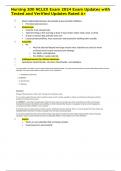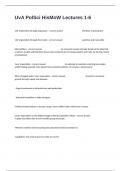Samenvatting
Summary Statistics 3 Clinical Track - English - Year 3, Period 4 - Psychology VU Amsterdam
- Instelling
- Vrije Universiteit Amsterdam (VU)
This is an English summary of the information for statistics 3 for the clinical track (statistiek 3 voor de klinische leerlijn). Statistics 2 is also repeated. The summary explains each test one by one in a logical order. I also included extra explanations on topics I thought were a bit vague in th...
[Meer zien]













